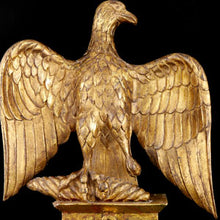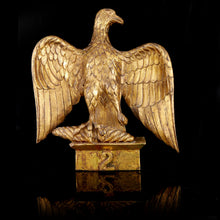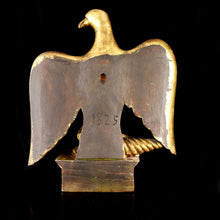Model of the Imperial Eagle of Napoleon’s 2e Regiment d'Infanterie de Ligne, 1825
Adding product to your cart
Height: 32cm (12.5in)
Gilt wood. Carved in the form of the Imperial Eagle of the 2nd Line Infantry Regiment of the Grande Armée, with outstretched wings and head turned to sinister, talons gripping Jupiter’s spindle on a pediment applied with the regiment’s number in the French Line. Dated 1825 to the reverse.
Possibly made by or for a veteran to commemorate service in the four battalion 2nd Infantry of the Line between 1804 and the fall of the empire in 1815, the regimental eagle bore the same significance to French Imperial regiments as the colours did to their British equivalents - to lose either brought shame to those who pledged to defend it.
Read more
The 2nd Line Infantry served across Europe and famously saw sea service, embarking troops at Toulon in the years XII (1804) to the year XIV (1805) and seeing service is at the Battle of Trafalgar on 21 October of the latter year. The regiment was subsequently deployed in the 1806 campaign of the Army of Italy, in the Observation Corps of the Grande Army (1807), and in 1808 in the Observation Corps of the Pyrenees, in 1809 in the Armies of Spain and Germany where it participated in the epic Battles of Essling-Aspern and Wagram. The regiment was represented in the 1810 campaigns in Germany; in the Observation Corps of Holland in 1811; and in the Army of Catalonia. In 1812 it marched with the Grand Army in the invasion of Russia and participated in the battles of Polotsk and the Berezina. In 1813 and 1814 it was with the Army of Portugal in the 2nd Corps of the Grand Army, with which it was engaged in the battles of Dresden and Leipzig (16-19 October) and in the garrisons of Custrin and Magdeburg and in the observation corps of Meden. During the French campaign in 1814 it fought at the Battle of La Rothière. After the exile of Napoleon to Elba, and the return of Louis XVIIIit took the title of the Queen's Regiment in Paris but at the onset of the Hundred Days Napoleon I issued a decree on 20 April 1815 which restored to the old line infantry regiments the numbers they had lost.












